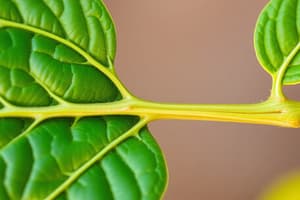Podcast
Questions and Answers
What does the presence of dye solution in the xylem regions of the plant stems indicate?
What does the presence of dye solution in the xylem regions of the plant stems indicate?
- Water absorption in roots is impaired.
- Transport of water and dissolved substances is occurring. (correct)
- The plant is incapable of photosynthesis.
- The plant is in a state of active desiccation.
Which plant sample is likely to exhibit the highest rate of transport based on structural integrity?
Which plant sample is likely to exhibit the highest rate of transport based on structural integrity?
- Intact plant (correct)
- Cut off roots A
- Decapitated plant
- Cut off roots + decapitated
What factors can lead to a reduced rate of transport in plants?
What factors can lead to a reduced rate of transport in plants?
- Excessive water supply
- Damage to the root structure (correct)
- High levels of sunlight
- Optimal temperature conditions
Why is it important for plants to maintain a favorable water balance?
Why is it important for plants to maintain a favorable water balance?
What could be the consequence of prolonged desiccation in an actively growing plant?
What could be the consequence of prolonged desiccation in an actively growing plant?
What role do the roots play in the transport process of plants?
What role do the roots play in the transport process of plants?
How does drying the cut off roots B before dye immersion affect the rate of transport?
How does drying the cut off roots B before dye immersion affect the rate of transport?
What might indicate that a plant's xylem is non-functional?
What might indicate that a plant's xylem is non-functional?
What should be done with the intact plant before immersion in the dye solution?
What should be done with the intact plant before immersion in the dye solution?
What differentiates the handling of the 'Cut off roots B' plant from the 'Cut off roots A' plant?
What differentiates the handling of the 'Cut off roots B' plant from the 'Cut off roots A' plant?
After how long should the plants be removed from the dye solution?
After how long should the plants be removed from the dye solution?
What is the purpose of using a razor blade during the procedure?
What is the purpose of using a razor blade during the procedure?
Which plant part is distinguished as containing xylem and phloem tissues?
Which plant part is distinguished as containing xylem and phloem tissues?
What should be done to the plants after immersion and waiting for 60 minutes?
What should be done to the plants after immersion and waiting for 60 minutes?
How is the rate of dye transport calculated after measuring the distance traveled?
How is the rate of dye transport calculated after measuring the distance traveled?
What is the role of bond paper in the procedure?
What is the role of bond paper in the procedure?
Flashcards are hidden until you start studying
Study Notes
Water in Plants
- Plants need water for growth and survival
- Water is essential for maintaining physiological activity within cells and the whole plant.
- Insufficient water leads to stunted development and slower rates of vital functions.
- Excessive water loss is lethal to plants.
Experiment: Observing Transport in Plants
- The experiment uses ethylene blue dye to observe transport pathways in plants.
- Five plant samples are used: intact, decapitated, cut-off roots A (cut underwater), cut-off roots B (cut in air), and cut-off + decapitated.
- The dye travels through the xylem and phloem of the plant.
- Xylem transports water and minerals upwards from the roots to the rest of the plant.
- Phloem transports sugars and other organic materials throughout the plant.
Observing Dye Movement
- After 60 minutes, the plants are removed from the dye solution and examined.
- A thin section of the base of each plant is cut and mounted on a slide for microscopic observation.
- The location of the dye in the xylem and phloem is observed.
- The distance traveled by the dye in each plant is measured.
- The rate of transport is calculated by dividing the distance traveled by the time immersed in the dye.
Comparing Transport Rates
- The plant with the highest rate of transport is the intact plant. This is likely due to all tissues being present and functional.
- The plant with the lowest rate of transport is the cut-off roots B plant. This is likely because of the air exposure, which can block the xylem and reduce the water transport.
- The decapitated plant shows a reduced rate of transport because the top of the plant is removed. This prevents the water from traveling up to the leaves and the rate of transpiration is affected.
Important Experiment Points
- The cut-off roots A plant is cut underwater to avoid air embolism, which can block the xylem.
- The cut-off roots B plant is left in air for 15 minutes to allow for air embolism to occur.
- The plant with both roots and crown removed shows a significant decrease in the rate of transport because it lacks both the roots to absorb water and the leaves to transpire.
Studying That Suits You
Use AI to generate personalized quizzes and flashcards to suit your learning preferences.




